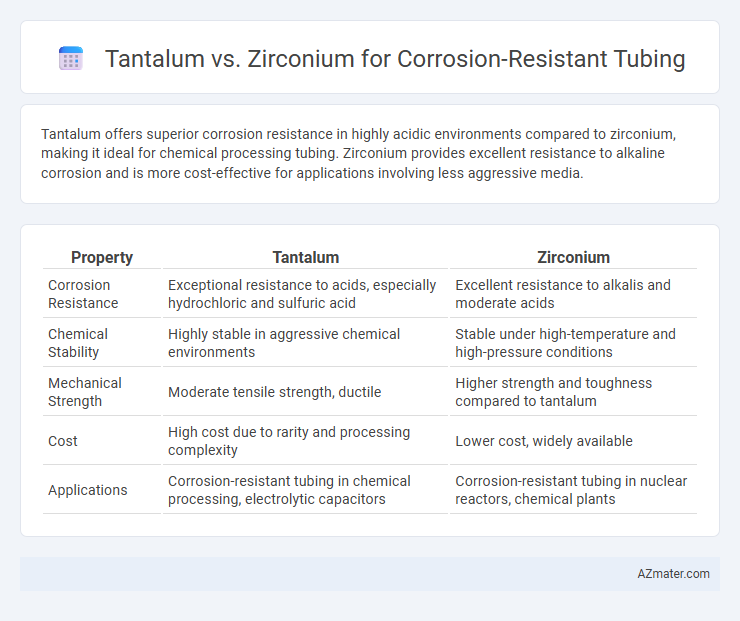Tantalum offers superior corrosion resistance in highly acidic environments compared to zirconium, making it ideal for chemical processing tubing. Zirconium provides excellent resistance to alkaline corrosion and is more cost-effective for applications involving less aggressive media.
Table of Comparison
| Property | Tantalum | Zirconium |
|---|---|---|
| Corrosion Resistance | Exceptional resistance to acids, especially hydrochloric and sulfuric acid | Excellent resistance to alkalis and moderate acids |
| Chemical Stability | Highly stable in aggressive chemical environments | Stable under high-temperature and high-pressure conditions |
| Mechanical Strength | Moderate tensile strength, ductile | Higher strength and toughness compared to tantalum |
| Cost | High cost due to rarity and processing complexity | Lower cost, widely available |
| Applications | Corrosion-resistant tubing in chemical processing, electrolytic capacitors | Corrosion-resistant tubing in nuclear reactors, chemical plants |
Introduction to Corrosion-Resistant Tubing
Tantalum and zirconium are critical materials for corrosion-resistant tubing used in chemical processing industries, where exposure to aggressive acids and high temperatures is common. Tantalum offers exceptional resistance to strong acids such as hydrochloric and sulfuric acid, making it ideal for highly corrosive environments. Zirconium, known for its high strength and resistance to chloride-induced stress corrosion cracking, excels in applications involving high-temperature and oxidative conditions.
Overview of Tantalum Tubing
Tantalum tubing offers exceptional corrosion resistance, particularly in aggressive chemical environments such as hydrochloric and sulfuric acids, due to its stable oxide layer. Its high melting point and excellent ductility make it ideal for applications in chemical processing and aerospace industries where durability and reliability are critical. Compared to zirconium, tantalum provides superior resistance to pitting and crevice corrosion, enhancing the longevity of corrosion-resistant tubing systems.
Overview of Zirconium Tubing
Zirconium tubing offers superior corrosion resistance in aggressive environments such as chemical processing and nuclear reactors, primarily due to its strong passivation layer of zirconium oxide. Its excellent resistance to chloride-induced stress corrosion cracking and compatibility with high-temperature and high-pressure conditions make it ideal for demanding industrial applications. Compared to tantalum, zirconium is often preferred in environments where both mechanical strength and corrosion resistance are critical, especially in aqueous and acidic media.
Corrosion Resistance Properties: Tantalum vs Zirconium
Tantalum exhibits exceptional corrosion resistance in highly aggressive environments, including strong acids like hydrofluoric and sulfuric acid, due to its stable oxide layer and inert chemical nature. Zirconium also offers excellent corrosion resistance, particularly in oxidizing and reducing environments, with superior resistance to chloride-induced pitting and stress corrosion cracking. The choice between tantalum and zirconium for corrosion-resistant tubing depends on specific chemical exposure, with tantalum preferred for highly acidic conditions and zirconium favored in chloride-rich or oxidizing applications.
Mechanical Strength and Durability Comparison
Tantalum offers superior corrosion resistance and exceptional mechanical strength under high-temperature and aggressive chemical environments, making it ideal for tubing in harsh industrial applications. Zirconium provides excellent resistance to corrosion, particularly against acids, and exhibits high ductility and toughness, enhancing its durability in varying temperature conditions. While tantalum generally outperforms zirconium in strength at elevated temperatures, zirconium's cost-effectiveness and good mechanical properties make it suitable for applications requiring both corrosion resistance and moderate mechanical strength.
Cost Analysis: Tantalum vs Zirconium Tubing
Tantalum tubing exhibits superior corrosion resistance in highly aggressive environments but commands a significantly higher price per pound compared to zirconium, making it a premium choice for specialized applications. Zirconium tubing offers a more cost-effective solution with excellent resistance to chlorine and acidic media, striking a balance between performance and budget constraints. Cost analysis reveals that while tantalum's upfront expense is higher, its longevity and minimal maintenance can justify investment in extreme conditions, whereas zirconium suits large-scale industrial uses where cost efficiency is paramount.
Industrial Applications and Use Cases
Tantalum offers exceptional corrosion resistance in highly acidic environments, making it ideal for chemical processing equipment and heat exchangers in industrial applications dealing with strong acids like sulfuric and hydrochloric acid. Zirconium excels in resisting stress corrosion cracking and high-temperature oxidation, which suits it for nuclear reactors and petrochemical industries handling aggressive chloride-containing solutions. Both metals are preferred for corrosion-resistant tubing but are selected based on specific chemical environments and operational temperatures to optimize longevity and safety in industrial use cases.
Fabrication and Welding Differences
Tantalum tubing offers superior corrosion resistance and excellent weldability due to its ductile nature and ability to form strong, defect-free weld joints, making it ideal for chemical processing applications. Zirconium, while also corrosion-resistant, requires more specialized welding techniques such as inert gas shielding and precise heat control to prevent oxidation and embrittlement during fabrication. The differing thermal conductivities and metallurgical properties of tantalum and zirconium significantly influence their welding parameters and fabrication methods, impacting overall performance in aggressive environments.
Longevity and Maintenance Considerations
Tantalum offers exceptional corrosion resistance in highly aggressive environments, leading to longer tubing lifespan and minimal maintenance due to its strong resistance to acids like hydrochloric and sulfuric acid. Zirconium, while slightly less corrosion-resistant than tantalum, excels in handling oxidizing agents and shows superior mechanical strength, contributing to durability under high-stress conditions and less frequent replacement. Maintenance considerations favor tantalum for environments with severe acid exposure, whereas zirconium tubing is preferred in applications requiring robust structural integrity alongside corrosion resistance.
Choosing the Optimal Material for Corrosion-Resistant Tubing
Tantalum offers exceptional resistance to strong acids, making it ideal for highly corrosive environments, while zirconium excels in high-temperature and chloride-rich conditions due to its strong oxide layer. Selecting the optimal corrosion-resistant tubing material depends on assessing the specific chemical exposure, temperature, and mechanical stress of the application. Balancing cost with the corrosion resistance properties of tantalum and zirconium ensures long-term performance and durability in industrial systems.

Infographic: Tantalum vs Zirconium for Corrosion-resistant Tubing
 azmater.com
azmater.com